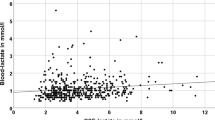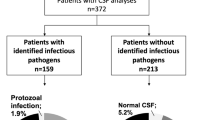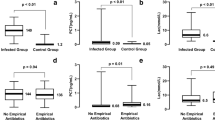Abstract
CSF lactate measurement is recommended when nosocomial meningitis is suspected, but its value in community-acquired bacterial meningitis is controversial. We evaluated the diagnostic performance of lactate and other CSF parameters in a prospective cohort of adult patients with acute meningitis. Diagnostic accuracy of lactate and other CSF parameters in patients with microbiologically documented episodes was assessed by receiver operating characteristic (ROC) curves. The cut-offs with the best diagnostic performance were determined. Forty-five of 61 patients (74 %) had a documented bacterial (n = 18; S. pneumoniae, 11; N. meningitidis, 5; other, 2) or viral (n = 27 enterovirus, 21; VZV, 3; other, 3) etiology. CSF parameters were significantly different in bacterial vs. viral meningitis, respectively (p < 0.001 for all comparisons): white cell count (median 1333 vs. 143/mm3), proteins (median 4115 vs. 829 mg/l), CSF/blood glucose ratio (median 0.1 vs. 0.52), lactate (median 13 vs. 2.3 mmol/l). ROC curve analysis showed that CSF lactate had the highest accuracy for discriminating bacterial from viral meningitis, with a cutoff set at 3.5 mmol/l providing 100 % sensitivity, specificity, PPV, NPV, and efficiency. CSF lactate had the best accuracy for discriminating bacterial from viral meningitis and should be included in the initial diagnostic workup of this condition.


Similar content being viewed by others
References
Thigpen MC, Whitney CG, Messonnier NE, Zell ER, Lynfield R, Hadler JL, Harrison LH, Farley MM, Reingold A, Bennett NM, Craig AS, Schaffner W, Thomas A, Lewis MM, Scallan E, Schuchat A, Emerging Infections Programs Network (2011) Bacterial meningitis in the United States, 1998–2007. N Engl J Med 364(21):2016–2025
Romero JR (2014) Viral meningitis and aseptic meningitis syndrome. In: Scheld WM, Whitley RJ, Marra CM (eds) Infections of the central nervous system. Lippincott Williams & Wilkins, Philadelphia, pp 65–83
van de Beek D, de Gans J, Tunkel AR, Wijdicks EF (2006) Community-acquired bacterial meningitis in adults. N Engl J Med 354(1):44–53
Logan SA, MacMahon E (2008) Viral meningitis. BMJ 336(7634):36–40
Aronin SI, Peduzzi P, Quagliarello VJ (1998) Community-acquired bacterial meningitis: risk stratification for adverse clinical outcome and effect of antibiotic timing. Ann Intern Med 129(11):862–869
Auburtin M, Wolff M, Charpentier J, Varon E, Le Tulzo Y, Girault C, Mohammedi I, Renard B, Mourvillier B, Bruneel F, Ricard JD, Timsit JF (2006) Detrimental role of delayed antibiotic administration and penicillin-nonsusceptible strains in adult intensive care unit patients with pneumococcal meningitis: the PNEUMOREA prospective multicenter study. Crit Care Med 34(11):2758–2765
Brouwer MC, Thwaites GE, Tunkel AR, van de Beek D (2012) Dilemmas in the diagnosis of acute community-acquired bacterial meningitis. Lancet 380(9854):1684–1692
Nigrovic LE, Kuppermann N, Macias CG, Cannavino CR, Moro-Sutherland DM, Schremmer RD, Schwab SH, Agrawal D, Mansour KM, Bennett JE, Katsogridakis YL, Mohseni MM, Bulloch B, Steele DW, Kaplan RL, Herman MI, Bandyopadhyay S, Dayan P, Truong UT, Wang VJ, Bonsu BK, Chapman JL, Kanegaye JT, Malley R, Pediatric Emergency Medicine Collaborative Research Committee of the American Academy of Pediatrics (2007) Clinical prediction rule for identifying children with cerebrospinal fluid pleocytosis at very low risk of bacterial meningitis. JAMA 297(1):52–60
Spanos A, Harrell FE Jr, Durack DT (1989) Differential diagnosis of acute meningitis. An analysis of the predictive value of initial observations. JAMA 262(19):2700–2707
Tunkel AR, Hartman BJ, Kaplan SL, Kaufman BA, Roos KL, Scheld WM, Whitley RJ (2004) Practice guidelines for the management of bacterial meningitis. Clin Infect Dis 39(9):1267–1284
Huy NT, Thao NT, Diep DT, Kikuchi M, Zamora J, Hirayama K (2010) Cerebrospinal fluid lactate concentration to distinguish bacterial from aseptic meningitis: a systemic review and meta-analysis. Crit Care 14(6):R240
Prasad K, Sahu JK (2011) Cerebrospinal fluid lactate: is it a reliable and valid marker to distinguish between acute bacterial meningitis and aseptic meningitis? Crit Care 15(1):104
Giulieri SG, Chapuis-Taillard C, Manuel O, Hugli O, Pinget C, Wasserfallen JB, Sahli R, Jaton K, Marchetti O, Meylan P (2015) Rapid detection of enterovirus in cerebrospinal fluid by a fully-automated PCR assay is associated with improved management of aseptic meningitis in adult patients. J Clin Virol 62:58–62
Horan TC, Andrus M, Dudeck MA (2008) CDC/NHSN surveillance definition of health care-associated infection and criteria for specific types of infections in the acute care setting. Am J Infect Control 36(5):309–332
de Gans J, van de Beek D, European Dexamethasone in Adulthood Bacterial Meningitis Study Investigators (2002) Dexamethasone in adults with bacterial meningitis. N Engl J Med 347(20):1549–1556
Corless CE, Guiver M, Borrow R, Edwards-Jones V, Fox AJ, Kaczmarski EB (2001) Simultaneous detection of Neisseria meningitidis, Haemophilus influenzae, and streptococcus pneumoniae in suspected cases of meningitis and septicemia using real-time PCR. J Clin Microbiol 39(4):1553–1558
Rodriguez-Lazaro D, Hernandez M, Scortti M, Esteve T, Vazquez-Boland JA, Pla M (2004) Quantitative detection of Listeria monocytogenes and Listeria innocua by real-time PCR: assessment of hly, iap, and lin02483 targets and AmpliFluor technology. Appl Environ Microbiol 70(3):1366–1377
Posner JB, Plum F (1967) Independence of blood and cerebrospinal fluid lactate. Arch Neurol 16(5):492–496
Meli DN, Christen S, Leib SL, Tauber MG (2002) Current concepts in the pathogenesis of meningitis caused by Streptococcus pneumoniae. Curr Opin Infect Dis 15(3):253–257
Tureen J (1995) Effect of recombinant human tumor necrosis factor-alpha on cerebral oxygen uptake, cerebrospinal fluid lactate, and cerebral blood flow in the rabbit: role of nitric oxide. J Clin Invest 95(3):1086–1091
Guerra-Romero L, Tauber MG, Fournier MA, Tureen JH (1992) Lactate and glucose concentrations in brain interstitial fluid, cerebrospinal fluid, and serum during experimental pneumococcal meningitis. J Infect Dis 166(3):546–550
White NJ, Warrell DA, Looareesuwan S, Chanthavanich P, Phillips RE, Pongpaew P (1985) Pathophysiological and prognostic significance of cerebrospinal-fluid lactate in cerebral malaria. Lancet 1(8432):776–778
Cunha BA (2013) The clinical and laboratory diagnosis of acute meningitis and acute encephalitis. Expert Opin Med Diagn 7(4):343–364
Maskin LP, Capparelli F, Mora A, Hlavnicka A, Orellana N, Díaz MF, Wainsztein N, Del Castillo M. Cerebrospinal fluid lactate in post-neurosurgical bacterial meningitis diagnosis. Clin Neurol Neurosurg 115(9):1820–1825
Leib SL, Boscacci R, Gratzl O, Zimmerli W (1999) Predictive value of cerebrospinal fluid (CSF) lactate level versus CSF/blood glucose ratio for the diagnosis of bacterial meningitis following neurosurgery. Clin Infect Dis 29(1):69–74
Genton B, Berger JP (1990) Cerebrospinal fluid lactate in 78 cases of adult meningitis. Intensive Care Med 16(3):196–200
Sakushima K, Hayashino Y, Kawaguchi T, Jackson JL, Fukuhara S (2011) Diagnostic accuracy of cerebrospinal fluid lactate for differentiating bacterial meningitis from aseptic meningitis: a meta-analysis. J Infect 62(4):255–262
Ponka A, Ojala K, Teppo AM, Weber TH (1983) The differential diagnosis of bacterial and aseptic meningitis using cerebrospinal fluid laboratory tests. Infection 11(3):129–131
Mandal BK, Dunbar EM, Hooper J, Parker L (1983) How useful is cerebrospinal fluid lactate estimation in differential diagnosis of meningitis? J Infect 6(3):231–237
Briem H (1983) Comparison between cerebrospinal fluid concentrations of glucose, total protein, chloride, lactate, and total amino acids for the differential diagnosis of patients with meningitis. Scand J Infect Dis 15(3):277–284
Eross J, Silink M, Dorman D (1981) Cerebrospinal fluid lactic acidosis in bacterial meningitis. Arch Dis Child 56(9):692–698
Majwala A, Burke R, Patterson W, Pinkerton R, Muzoora C, Wilson LA, Moore CC (2013) Handheld point-of-care cerebrospinal fluid lactate testing predicts bacterial meningitis in Uganda. Am J Trop Med Hyg 88(1):127–131
Acknowledgments
We thank Prof. Jean-Daniel Baumgartner, Morges, Switzerland and Dr. Laurent Christin, Nyon, Switzerland for their participation in the acute meningitis cohort study.
We thank Drs. Daniel Bardy and Olivier Boulat, Laboratory of Clinical Chemistry, Department of Laboratories, Lausanne University Hospital (CHUV), for providing technical information on the studied CSF parameters.
Study funding
The study was partially supported by unrestricted research grants from the Quality Control Program of the Lausanne University Hospital (Project # 127) and the Foundation for the Advancement in Medical Microbiology and Infectious Diseases (FAMMID), Lausanne, Switzerland.
Conflict of interest
The authors declare no competing financial interest in relation to the manuscript.
Author information
Authors and Affiliations
Corresponding author
Additional information
This study received the ICAAC Program Committee Award in Clinical Microbiology and Diagnosis at the 52nd ICAAC, San Francisco, CA, USA, September 9–12, 2012 (Oral presentation 1321 - # L1-1221, session “New Insights in Bacterial Meningitis”) and was presented at the Annual Meeting of the Swiss Societies for Infectious Diseases, Hospital Hygiene, and Travel Medicine, Lugano, May 30, 2013 (Oral presentation).
O. Manuel and O. Marchetti contributed equally to this work.
Rights and permissions
About this article
Cite this article
Giulieri, S., Chapuis-Taillard, C., Jaton, K. et al. CSF lactate for accurate diagnosis of community-acquired bacterial meningitis. Eur J Clin Microbiol Infect Dis 34, 2049–2055 (2015). https://doi.org/10.1007/s10096-015-2450-6
Received:
Accepted:
Published:
Issue Date:
DOI: https://doi.org/10.1007/s10096-015-2450-6




